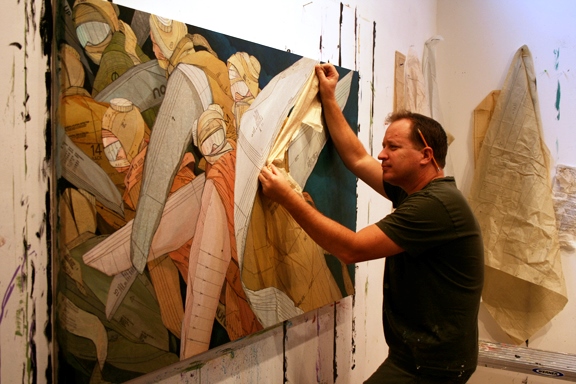
John Westmark’s work has been exhibited widely and is held in collections worldwide. In 2011, he was awarded a Pollock-Krasner grant and was selected as a finalist for the Arte Laguna painting prize and exhibition, Venice, Italy. In 2012, John was awarded The Gibbes Museum of Art Factor Prize for Southern Art. (Charleston, SC) The Factor Prize acknowledges an artist whose work demonstrates the highest level of artistic achievement in any media while contributing to a new understanding of art in the South. John's work was selected to appear in Art Takes Miami (2012 edition), a limited edition publication distributed to galleries, art critics, collectors, and journalists. His work has also been featured in New American Paintings, American Art Collector, and Studio Visit Magazine.
John received an MFA from the University of Florida and a BFA from the Kansas City Art Institute. He currently lives and works in Gainesville, Florida.
This show presents a dichotomy between male and female stereotypes: sewing, personal garment making, and the female figure, compared and contrasted with engineering, schematics and aircraft. The primary material used in these paintings is store-bought paper sewing patterns applied directly to the canvas – the patterns are reinterpreted outside of their usual functional context as garment templates. I am interested in the metaphorical potential of these unorthodox materials.
The "fancy" paintings depict the female figure as an agent of revolt or mythological entity. The garment patterns in the work are embellished with custom text from contemporary feminist writing and criticism, creating a conceptual narrative alongside the existing material "narrative" of imprinted assembly instructions. The viewer is asked to read both the material and the image. Likewise, in the "flight" paintings, a graphic metaphor is created between the diagrammatic instructions of garment making and the engineered schematics of "flying" machines.
In both bodies of work, an ambiguity of viewpoint is presented: in the "fancy" paintings, the identity of the figure(s) is obscured by wraps, bonnets and bound faces. The denial of a specific identity suggests an anonymous "everywoman," not invisible, but fractious. The "flight" work also embodies a partial narrative in that the viewer is denied a conclusion. Are the depicted forms coming together or falling apart? Are they rising or descending? Are they aircraft, kites, sails, or figures? Are they male or
female - strong or fragile?
This work explores the relationship between how a pattern looks in contrast to how it is intended to be used. Essentially, patterns and templates are the genesis of assembly. My goal with these paintings is to expose and liberate the pattern to become something else; something to keep.